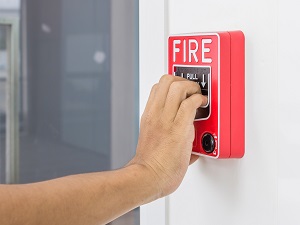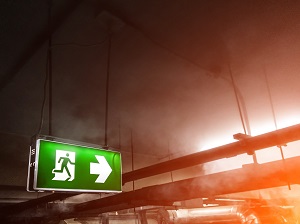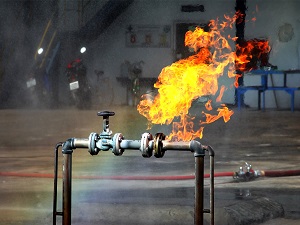Employees should know the questions to ask when considering whether or not to fight a small fire at work, how to safely attempt to put out a fire with a portable fire extinguisher, and what to do if evacuation becomes the only option.

All workers should have a clear understanding of the organization’s fire safety plan. Guidance to employees should include when it might be appropriate and helpful to fight a small fire with a portable fire extinguisher and when it’s the right decision to evacuate immediately.
OSHA Standard 1926.150(a)(1) The employer shall be responsible for the development of a fire protection program to be followed throughout all phases of the construction and demolition work, and shall provide for the firefighting equipment.
Portable fire extinguishers are labeled with color-coded letters and/or pictograms that indicate the type of fire they are designed to extinguish. It is critically important that the right type of extinguisher be used on the specific class of fire to avoid personal injury and damage to property. Using the wrong type of fire extinguisher could be ineffective, result in electrical shock, cause an explosion or even spread the fire.
OSHA Standard 1910.157(g)(1) Where the employer has provided portable fire extinguishers for employee use in the workplace, the employer shall also provide an educational program to familiarize employees with the general principles of fire extinguisher use and the hazards involved with incipient stage fire fighting.

Personnel who are trained and authorized to use portable fire extinguishers must know how to conduct a risk assessment to determine whether or not it is safe to fight a fire or if the best course of action is to evacuate. Before attempting to extinguish any fire, consider these questions first.
How big is the fire?
Only attempt to put out a fire if it is contained to a small area, is in the early stages of developing, and has not started to spread quickly, also known as an incipient stage fire.
Is the atmosphere safe?
If you can see a lot of smoke, feel hot temperatures, have limited visibility or know there are hazardous materials in the area, then do not attempt to stay and fight the fire.
Where is the escape route?
If you attempt to fight a fire, an escape route should be behind you. Do not use a fire extinguisher if your means of evacuation is not clear or compromised.
Is the correct fire extinguisher available?
Make sure the fire extinguisher you have on hand matches the type of fuel that is burning.
Are you calm and in control?
If you feel panicked, overwhelmed or unsure of the situation, do not attempt to fight the fire.

When the decision has been made to attempt to put out a fire, take these actions first, before pulling the pin on the fire extinguisher.
- Activate the fire alarm system and notify emergency services, or delegate someone to do this.
- Ensure that personnel evacuation has started and all other workers are safely exiting the area.
- Identify a safe evacuation route.
Remember, the best method for using a fire extinguisher is with the acronym PASS, which stands for Pull, Aim, Squeeze and Sweep.
- Pull the pin in the handle of the fire extinguisher.
- Aim the hose or nozzle at the base of the fire while making sure you are a safe distance away.
- Squeeze the operating lever slowly to expel the fire extinguishing agent onto the fire.
- Sweep the hose or nozzle from side to side, at the base of the fire, until the fire is out. Move forward or around the area where the fire is, if it is safe to do so, as the fire diminishes. Watch the area closely after the fire seems to be out to ensure re-ignition won’t occur.

After successfully extinguishing any fire:
- Maintain a reliable escape route until it is confirmed that the fire is completely out.
- Monitor conditions for at least 30 minutes to ensure the fire does not reignite.
- Avoid exposure to the extinguishing agent because some fire extinguisher chemicals can irritate your skin or respiratory system.
Once the fire extinguisher is empty, evacuate immediately if you were unable to put the fire out. If indoors, close the door behind you to help confine the fire. Ensure emergency services has been notified and all other personnel have also evacuated the area or the building.
If no person on site attempts to extinguish the fire, then all personnel should evacuate the area immediately. If indoors, everyone should exit the building, no matter how far away from the fire they are located.
- Evacuate the immediate area of the fire.
- Activate the fire alarm system and call 911 or notify emergency services.
- Evacuate the building.
- Remain outside until notified by the fire department that the building is safe to re-enter.

Do not attempt to extinguish a workplace fire if…
- you are not trained in portable fire extinguisher use.
- the fire is spreading rapidly beyond the point of origin.
- smoke is quickly filling the room.
- you do not have a safe escape route to your back.
- the fire has flames that are higher than your head.
- adequate fire extinguishing equipment is not available.
- you do not know the source of the fire.
- there are flammable solvents or hazardous materials in the area.
- the air is unsafe to breathe and there is a need for respiratory protection.
- it is too hot to get within 10-15 feet of the fire.
Report any fire extinguishers that have been used. Even if the extinguisher was used for a short time, it should be reported as used.
If using a carbon dioxide fire extinguisher, do not touch the plastic horn as it can become very cold and cause damage to skin.


.jpeg)
